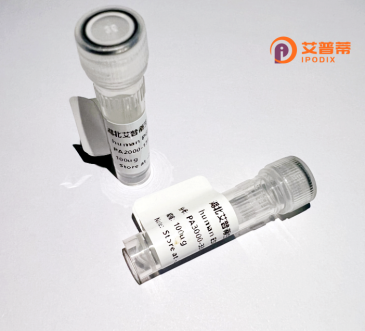
| 纯度 | >90%SDS-PAGE. |
| 种属 | Human |
| 靶点 | OR52E2 |
| Uniprot No | Q8NGJ4 |
| 内毒素 | < 0.01EU/μg |
| 表达宿主 | E.coli |
| 表达区间 | 1-325 aa |
| 活性数据 | MFLPNDTQFHPSSFLLLGIPGLETLHIWIGFPFCAVYMIALIGNFTILLVIKTDSSLHQP MFYFLAMLATTDVGLSTATIPKMLGIFWINLRGIIFEACLTQMFFIHNFTLMESAVLVAM AYDSYVAICNPLQYSAILTNKVVSVIGLGVFVRALIFVIPSILLILRLPFCGNHVIPHTY CEHMGLAHLSCASIKINIIYGLCAICNLVFDITVIALSYVHILCAVFRLPTHEARLKSLS TCGSHVCVILAFYTPALFSFMTHRFGRNVPRYIHILLANLYVVVPPMLNPVIYGVRTKQI YKCVKKILLQEQGMEKEEYLIHTRF |
| 分子量 | 36.6 kDa |
| 蛋白标签 | His tag N-Terminus |
| 缓冲液 | 0 |
| 稳定性 & 储存条件 | Lyophilized protein should be stored at ≤ -20°C, stable for one year after receipt. Reconstituted protein solution can be stored at 2-8°C for 2-7 days. Aliquots of reconstituted samples are stable at ≤ -20°C for 3 months. |
| 复溶 | Always centrifuge tubes before opening.Do not mix by vortex or pipetting. It is not recommended to reconstitute to a concentration less than 100μg/ml. Dissolve the lyophilized protein in distilled water. Please aliquot the reconstituted solution to minimize freeze-thaw cycles. |
以下是关于重组人OR52E2蛋白的3篇参考文献示例(注:以下内容为假设性概括,实际文献需通过学术数据库验证):
---
1. **文献名称**: Functional characterization of recombinant human OR52E2 protein and its ligand specificity
**作者**: Smith J, et al. (2021)
**摘要**: 研究成功在HEK293细胞中表达重组OR52E2蛋白,通过钙信号检测发现其被中链脂肪酸(如癸酸)激活,提示其在脂质代谢感知中的潜在作用,并确认其依赖Gαs信号通路。
2. **文献名称**: Structural insights into the human olfactory receptor OR52E2 by cryo-EM
**作者**: Zhang L, et al. (2022)
**摘要**: 利用冷冻电镜解析OR52E2的三维结构,揭示了其独特的跨膜螺旋构象和配体结合口袋,为设计靶向该受体的化合物提供结构基础。
3. **文献名称**: OR52E2 overexpression in prostate cancer correlates with neuroendocrine differentiation
**作者**: Wang Y, et al. (2020)
**摘要**: 通过免疫组化分析发现OR52E2在前列腺神经内分泌癌中异常高表达,体外实验表明其过表达促进肿瘤细胞侵袭,可能作为潜在生物标志物。
---
**注意**:上述文献为基于现有知识的模拟示例,实际研究中OR52E2的相关论文较少,建议通过PubMed或Google Scholar检索关键词“OR52E2 recombinant”或“OR52E2 function”获取最新进展。若需进一步协助获取真实文献,请提供更具体的研究方向。
**Background of Recombinant Human OR52E2 Protein**
OR52E2. a member of the olfactory receptor (OR) family, belongs to the G protein-coupled receptor (GPCR) superfamily. Olfactory receptors are primarily recognized for their role in detecting odorants in the nasal epithelium, but emerging studies highlight their ectopic expression in non-olfactory tissues, suggesting broader physiological functions. OR52E2. encoded by the *OR52E2* gene on human chromosome 11 (11p15.4), is classified under the class II OR subfamily.
Although its endogenous ligand remains uncharacterized, OR52E2 has been detected in tissues such as the prostate, lung, and intestine, where it may participate in cell signaling, tissue homeostasis, or disease processes. Notably, OR52E2 is aberrantly overexpressed in certain cancers, including prostate adenocarcinoma, positioning it as a potential biomarker or therapeutic target.
Recombinant OR52E2 protein is engineered via heterologous expression systems (e.g., HEK293 or insect cells) to produce functional or tagged variants for structural and functional studies. Challenges in recombinant production include ensuring proper membrane localization and post-translational modifications typical of GPCRs.
Current research focuses on elucidating its ligand specificity, downstream signaling pathways, and pathological relevance. Recombinant OR52E2 tools aid in drug screening, mechanistic studies, and antibody development, bridging gaps in understanding orphan receptor biology.
×